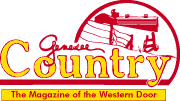
Genesee Country Magazine
Greatest Hits
Search Our Website!
 |
Genesee Country Magazine | Search Our Website! |
Related
Links: | GC Magazine Home | GC Greatest Hits | Clarion Publications | WNY Travel Guide |
This story was originally published in the 1994 August/September edition
|
Left: City of Rochester and New York State Police link batons to control a crowd that gathered on Clarissa Street in the heart of the '64 uprising. Right: State Police and a city patrolman arrest a man caught on Jefferson Avenue after the 8 p.m. curfew. |
It was Friday, July 24, 1964, and the city was stretched tight by a relentless heat wave.
The Northeastern Mothers Improvement Committee, had sponsored a dance on Nassau Street, just off Joseph Avenue in the city's predominately black Seventh Ward. As 250 young people gathered to seek some relief from the sweltering heat, the mothers sold barbecued ribs and soda to raise money for a neighborhood playground.
With only two police officers on routine traffic detail, everything seemed to be proceeding peacefully. The calm was deceptive. What happened next resulted in a three-day rampage that left five dead, 350 injured and nearly 1,000 under arrest. Before order was restored with the help of 450 state troopers and 1,500 National Guard troops, over 250 stores had been looted and over $2 million in property damaged. It was one of the nation's first large-scale civil disturbances, a precursor of the Watts riots which would hit Los Angeles a year later.
Just as the dance was scheduled to end at 11:30 p.m., police attempted to arrest a 21-year-old black man, who they claimed was drunk and harassing girls at the dance. The man put up a struggle and four police cars were called in for backup, including one carrying two German Shepherd police dogs.
“The trouble really began with the German Shepherds,” said Rochester Democrat & Chronicle police reporter John Omicinski, the first journalist on the scene. Four years earlier, Rochester police officials had agreed not to use dogs at African American events, so their presence inflamed the crowd.
“Some in the crowd had garbage lids trying to fend off the dogs.” Omnicinski said. “The dogs were snapping about 5 feet away from them. They got angry about the dogs . . .and then the glass really started flying.”
The crowd grew and took over the streets, sending the police running. Rochester police chief William Lombard reached the scene at 12:30 a.m. and found “a different situation from anything I'd seen in the past,” he recalled. “There was a roar in the sky, a noise I'd never heard before. You could hear glass breaking.”
Lombard waded into the
crowd and attempted to calm the waves of fury, but he was forced to retreat amid
a shower of stones. The mob rolled his car over. “There were just too many
people. There was no controlling them,” he said.
According to WebCounter
you are the
person to answer the Clarion Call
©2008 Clarion Publications, Inc. All
Rights Reserved.
This site designed by Clarion Communications.